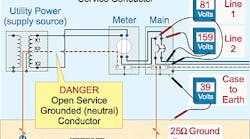Knowing the dangers of open service neutrals helps ensure safety.
The NEC limits lightning-induced voltage on the metal parts of service equipment. It also protects persons and property from fire by requiring you to ground those metal parts to earth [250.4(A)(2)]. Not only that, it limits the voltage imposed by line surges or unintentional contact with higher voltage lines.
Grounding the grounded (neutral) conductor to the earth shunts potentially dangerous energy from the system into the earth [250.4(A)(1)]. Utilities aren't required to install an equipment grounding conductor to service equipment. The NEC requires installers to run a grounded (neutral) conductor and bond it to the service disconnect enclosure from the electric utility transformer to each service disconnecting means (250.24). This grounded (neutral) service conductor serves as the effective ground-fault current path required to ensure that the circuit protection device will quickly remove dangerous ground fault voltage [250.4(A)(3) and 250.4(A)(5)].
If the grounded (neutral) service conductor is open or missing, objectionable neutral current will flow on metal parts of the electrical system. This potential electrical shock condition is of particular concern in buildings that contain swimming pools, spas, and hot tubs. Additionally, the operating voltage for the loads on one line will rise, while the operating voltage for the other line(s) will drop. When voltages are too far from required levels, the excess heat poses a fire hazard.
The voltage distribution on the circuits and the touch voltage on metal parts from an open service grounded (neutral) conductor vary according to load impedances and ground resistance. For example, consider the voltage distribution of a 3-wire, 120/240V service where Line 1 is 100A and Line 2 is 50A. You can apply these same concepts to different distribution systems and voltages. As we can see from the Table above:
-
The operating voltage for the load on Line 1 is below the equipment rating.
-
The operating voltage for the load on Line 2 is above the equipment rating.
-
The touch voltage is excessively high and dangerous.
If the grounded (neutral) service conductor, which serves as the effective ground-fault current path, is open or missing, protective devices can't clear a ground fault. As a result, metal parts of electrical equipment, metal piping, and structural steel will become — and remain — energized at line voltage, in this case, 120V.
A lower ground resistance would reduce touch voltage if the grounded (neutral) opens, but not likely to a safe value. If the grounded (neutral) service conductor is open, neutral current will flow onto the metal parts of the electrical system.
Avoid the trap of thinking that a low-resistance ground can prevent the dangers associated with an open neutral. Your only protection is to provide a monitoring device and take the appropriate action as soon as you discover the neutral is open.
Are you still confused by the Code? For additional information on Code-related topics please visit www.mikeholt.com or send an e-mail directly to the author at [email protected].




